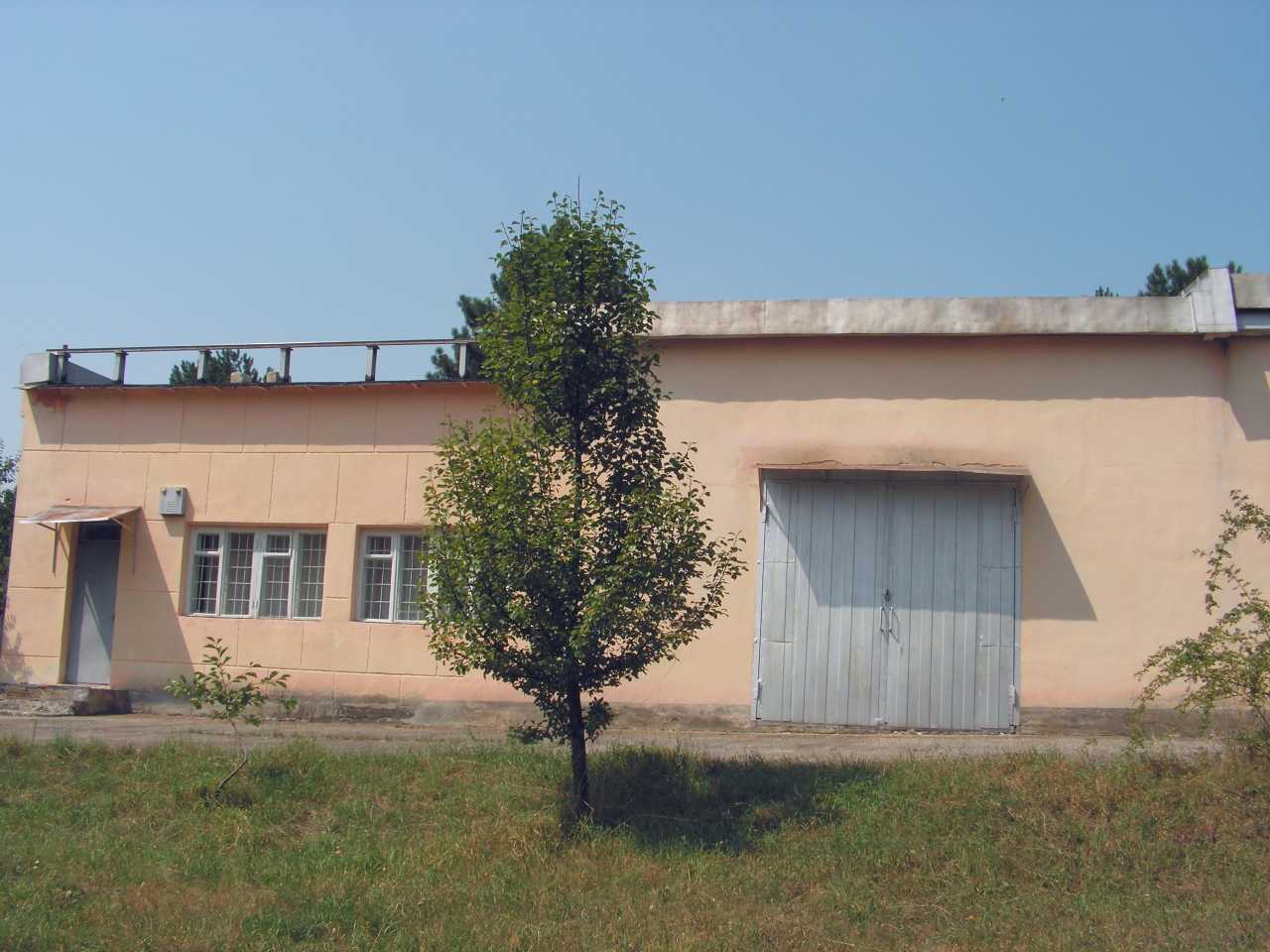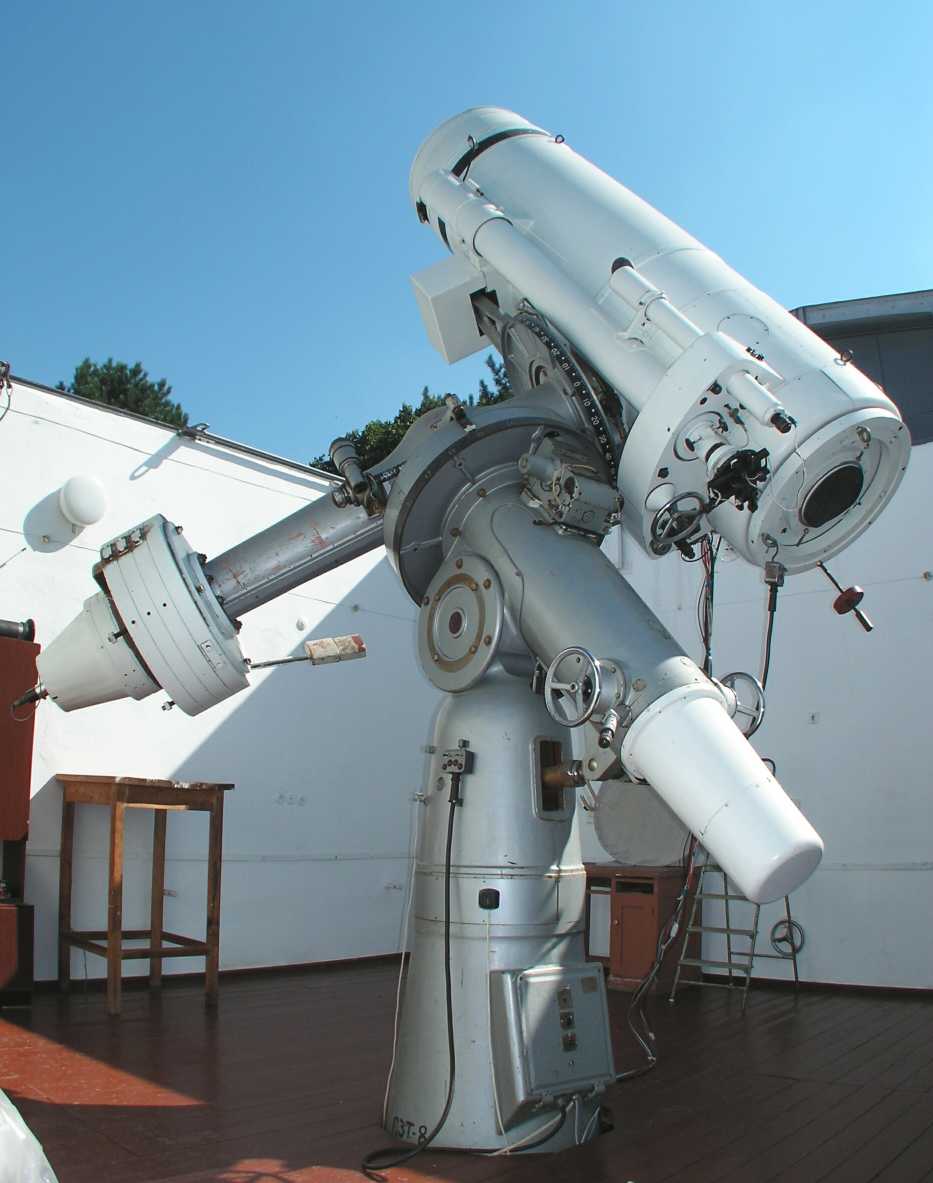AZT-8 70-cm Telescope
|
||||||||||
History |
||
|
Firstly the AZT-8 was installed in Simeiz in 1964. It was used for photoelectric photometry and polarimetry as well as for TV observations. Main goal of the observations was symbiotic and double stars (T.S.Belyakina, E.S.Brodskaya), T Tau-stars (P.P.Petrov), UV Cet-stars (P.F.Chugainov). |
||
|
In 1977 AZT-8 was transferred to Nauchny and installed in a new large pavilion with a shifting roof. Here AZT-8 was used to test a multichannel spectrometer constructed by A.F.Lagutin, L.V.Granitsky, A.B.Bukach et al. at the CrAO as a ground model for a device on board of the space mission "Astron". Main elements of the construction were designed and some particularites of the scanning drive and technical data of device were considered. |
||
|
As a by-product the rapid variations of the atmospheric extinction was investigated, and energy distribution of some C-type-stars was obtained. |
||
|
In 1990-s the photometric equipment for wide-range stellar photometry was developed in the Crimean Astrophysical Observatory in collaboration with Astronomical Institute of St.Petersburg University. Two telescopes (AZT-8, 0.7 m, F/18 and AZT-7, 0.2 m, F/10) on the same mount were equipped, correspondingly, with JKLM-photometer and BVR-photometer. The system permits to obtain simultaneous energy distribution for various stars in the range 0.4-5.0 mcm. The multicolor photometry of some X-ray-sources was carried out by V.M.Larionov, and some results of the BVR-photometry of RV Tau-type-stars were obtained by V.I.Burnashev. |
||
Instruments and Detectors |
||
|
The telescope was upgraded in the early 2000s (Sergeev et al. 2010). In 2001 the AP7p CCD camera has been installed in the prime focus of the AZT-8 to carry out BVRI photometric observations. The computer-controlled filter wheel for this camera was developed and manufactured at the Crimean Observatory. The CCD array has a size of 512×512 pixels, giving a field of view of 15'×15'. The camera has a set of B, V, R, R1, and I filters, where the filter designated R1 closely resembles the Cousins I filter, while the other filters closely resemble the standard Johnson filters (see Doroshenko et al. 2005 for more details). By December 2001, intensive photometric monitoring of Active Galactic Nuclei (AGNs), including quasars and BL Lac objects, has been started using this new photometer. The configuration and testing of the AP7p imaging system have been completed at the Ohio State University (OSU). The Quantex control computer was specially configured to operate the AP7p, and was assembled from spare parts at OSU. The computer-controlled pointing of the 70-cm telescope using optical encoders has been developed in 2002. All these equipment have been purchased under US Civilian Research and Development Foundation. |
||
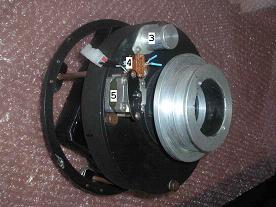
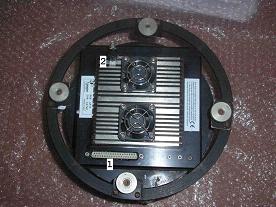
|
||
|
BVRI-photometer with the CCD camera AP7p. Numbers denote: 1 - Signal cable connector, |
|
||||||||||||||||||
|
Characteristics of the AP7p CCD camera. |
||||||||||||||||||
|

|
||||||||||||||||||||
| Filter transparency curves. | |||||||||||||||||||||
Observations |
||
|
When the control computer is loaded, its time is synchronized with the Universal Time and the Telescope control program starts. The program allows the telescope to be pointed at a specified position. Various types of information useful for an observer can be displayed: the start and end times of observations, the times of sunrise, sunset, moonrise, and moonset at the current date, the elevation of the observed object above the horizon, etc. In addition, the time interval during which the chosen object is accessible to observation or the time left until it becomes accessible to observation is displayed. Also shown are current telescope coordinates α, δ, and a hour angle t. |
||
|
Then the observer starts the program to control the process of observations. To set the object coordinates it is sufficient to select the object name from the database. When the coordinates are entered, the telescope control program will automatically choose an optimal telescope path in such a way that the lower end of the tube will not hit the supporting pillar and the tube will not sink below a dangerous limit in elevation above the horizon. The automatic pointing accuracy is about 2 arcmin, so the observer points the telescope more accurately manually by using the remote control (see number 6 on the figure below). |
||
|
After the pointing, the observer focuses the image and begins to expose the objects. It is possible to do either a single exposure or a sequence of exposures, both of them can be repeated a specified number of times. The standard sequence of exposures for AGNs consist of the B, V, R, R1, and I filters with exposure time to be 60, 40, 30, 25, and 40 s, respectively. These can be changed proportionally, depending on the object brightness. As a rule, for each object, the B, V, R, R1, and I sequence of exposures is repeated four times. Also exposed are the technical frames : bias, dark, and flat field. The flat field frames in each filter is usually obtained in the twilight sky at sunset or at sunrise. |
||
|
We have more than 50% of the telescope observing time. This time is mainly scheduled for photometric monitoring of selected AGNs to support for spectral observations as well as for the concurrent observations in other bands (HST, RXTE, BeppoSax), and to study patterns of the continuum variability, in particular, to measure a lag between different continuum bands. The list of targets to monitor consists of 50 AGNs of both Seyfert 1 and BL Lac types. Other observed objects are Super Novae, pre-main sequence stars, X-ray sources, GRB afterglow, and some other. Since December 2001, more than 320,000 CCD frames, including technical exposures, have been obtained, of which about 200,000 are AGN frames. |
||
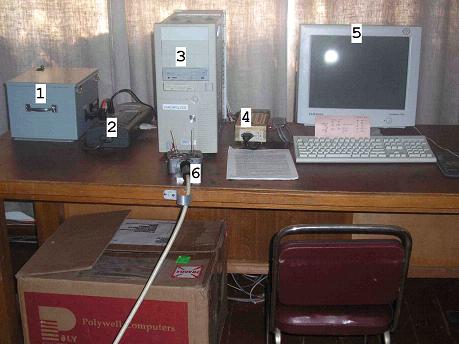
|
||
|
AZT-8 Observer place. Numbers denote: 1 - 220V to 110V power transformer, 2 - UPS, 3 - control computer, 4 - telescope control unit interface, 5 - computer monitor, and 6 - remote control for the thin telescope motion. |
||
Main Scientific Results |
||
|
1. Seyfert galaxies 1.1 Accretion disks It was found that the interband lags between flux variations in the B, V, R, and I bands of 17 AGNs depend on both the wavelength and the absolute luminosity. The lag depends on the luminosity as Lb, where b = 0.4–0.5. The timescales of the detected interband lags are consistent with standard disk models and radiative propagation of the variability "signal", so the lag can reflect the geometrical size of the region that emits the optical continuum. We suppose that the variability "signal" is driven by an X-ray source above the disk. Simulated lag-luminosity relationship is slightly displaced to the observed one. The agreement between both relationships can be improved by assuming that the Hubble constant is less than the accepted value of 75 km s-1 Mpk-1 (Sergeev et al. 2005, Sergeev 2014). Crimean photometric data has been used to develop a reprocessing model, which is able to reproduce the observed optical light curve from the X-ray light curve in the Mrk 79 and NGC 4051 nuclei. (Breedt et al. 2009, 2010). In terms of the International cooperation based on the multiwavelength observational data of NGC 5548, it was obtained an accretion disk model. The model yields the disk inclination i = 36±10°, temperature T1 = (44±6)×103 K at 1 light day from the black hole, and a temperature-radius slope T µ r–a, where a = 0.99±0.03 (Fausnaugh et al. 2016; Starkey et al. 2017). In terms of the International cooperation, the sizes of the accretion disks in two AGNs were determined. The determined sizes consistent with geometrically thin accretion-disk models that predict a lag-wavelength relation of t4/3, however, they are by 2-3 times greater than that expected from the standard model. The agreement can be achieved by increasing the accretion rate. (Fausnaugh et al. 2018). 1.2. Broad-line region (BLR) and black hole masses In terms of the International cooperation and by efforts of the Crimean researchers only, there were first determined or refined the black hole masses and the BLR sizes in many AGNs (Sergeev et al. 2007, 2011, 2017, 2020; Bentz et al. 2006, 2007; Denney et al. 2006, 2009, 2010; Onken et al. 2006; Grier et al. 2012a, 2012b; Doroshanko et al. 2012; Peterson et al. 2014; Pei et al. 2017; Fausnaugh et al. 2017). In particular, the 3C 390.3 nucleus has one of the most massive black hole (1.87±0.26 billion solar masses). The results of measuring the black hole masses and BLR sizes are consistent with the virial gas dynamics: V(r) ~ r–1/2. There were obtained the lag estimates for more than a dozen AGNs at various lile-of-sight velocities of the Hβ line profile, and, in several cases, of the Hα, Hγ, and He II λ4686Å line profiles. For several AGNs the two-dimensional Ψ(τ) response function of these lines has been recovered. The obtained results indicate the complexity and variety of gas kinematics in the BLR, with a predominance of virial motion (Keplerian rotation) for most AGNs. Evidence has been obtained that the BLR is multicomponent and that these components can be represented by disk and disk wind. Probably the kinematics of gas in AGN with broad double-peaked line profiles is a combination of Keplerian rotation and accretion (Denney et al. 2009; Doroshenko et al. 2012; Grier et al. 2013; De Rosa et al. 2018; Sergeev et al. 2020). 1.3 Comparison between the optical and X-ray variability In a number of papers there were performed a comparison between the optical and X-ray variability of several AGNs (Chesnok, Sergeev, Vavilova 2009; Doroshenko et al. 2009, 2010). 1.4 Other results on AGNs It was found and explained an anomaly in the behavior of the NGC 5548 nucleus; the long-term variability of the narrow emission lines in the 3C 390.3 nucleus has been found; a period of ~5700 days has been detected in the light curve of the NGC 5548 nucleus; the variability of the emission and absorption lines in the spectrum of the NGC 5548 nucleus has ben modeled; etc. (Doroshenko et al. 2005, 2006, 2008a, 2008b; Sergeev et al. 2007, 2017, 2020; Goad et al. 2016; Bon et al. 2010; Mathur et al. 2017; Kriss et al. 2019). 2. Blazars To be added... 3. Calibration of comparison stars in the fields of AGNs Comparison stars in the vicinity of 95 AGNs were calibrated in the B, V, R, Ic, and I magnitudes. The observed stars have magnitudes ranging from V=11 to V=17. For the stars brighter than V=14, the typical photometric uncertainty is 0.01 mag. The magnitudes of most of these stars were not known previously. (Doroshenko et al. 2005a, 2005b, 2007, 2008, 2013, 2014a, 2014b). 4. Papers not related to AGNs Supernovae (Doroshenko et al. 2003; Arcavi, Gal-Yam, Sergeev 2013). Variable stars (Sergeev et al. 2004; Doroshenko et al. 2008). Pre main sequence stars (Barsunova et al. 2005a, 2005b, 2006, 2013, 2015, 2016; Grinin et al. 2006, 2008a, 2008b, 2009a, 2009b, 2018, 2019). |
||
|
See also The goals and research problems. Scientific results. |
||


